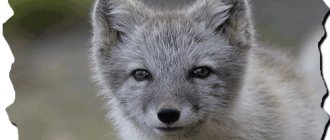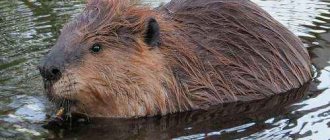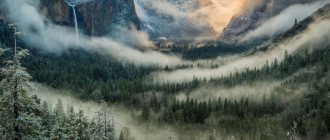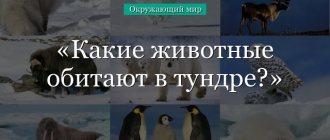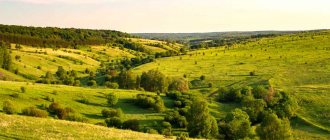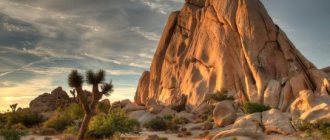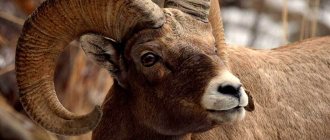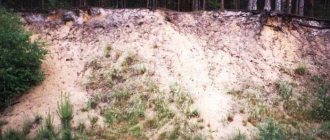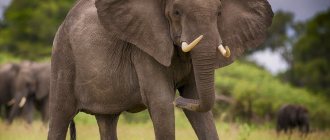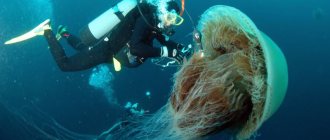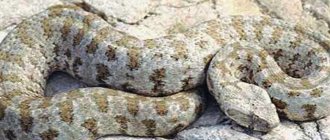Reindeer is a beautiful and amazing animal that lives in the tundra and taiga of North America and Eurasia. There are many interesting facts about him regarding his physical characteristics and behavior. Reindeer helped ancient tribes of people explore the vast expanses of the North. And currently remains a valuable biological resource for several northern peoples. However, uncontrolled hunting by poachers and human industrial activity are significantly reducing the population of these animals. Therefore, they were listed in the International Red Book as a vulnerable species.
In North America, deer are also called caribou.
Caribou is a subspecies of reindeer that lives in the North American arctic and subarctic latitudes, boreal forests and mountains (in the northern part of the temperate climate zone). In America, “caribou” are called wild animals, and “reindeer” are domesticated ones.
The caribou's North American range extends from Alaska through the Yukon, Northwest Territories and Nunavut in Canada. Populations have also been recorded in Greenland. Peary caribou, bowhead and Grant's reindeer live in the tundra, while woodland caribou prefer boreal forests. Caribou form large herds that spend long seasonal migrations in the tundra and taiga. The longest migrations are made by the Grant's reindeer herds, traveling through the northern latitudes of Canada and Alaska.
Some subspecies are considered rare and endangered (for example, Queen Charlotte Islands caribou). The historic range of woodland caribou formerly covered large areas of the central United States and Canada. However, human activities (in particular, deforestation, oil and gas production) have shifted the boundaries of animal habitats. Now small herds of forest caribou can be found in certain states in the northern USA (Washington, Idaho, etc.) and in southern Canada. In 2002, woodland caribou were designated as a critically endangered species by the Canadian Wildlife Conservation Committee COSEWIC.
Population and species status
Today, the world population of reindeer numbers more than 15 million animals. The main factors in its decline are hunting and human economic activity (deforestation, road construction, grazing of domestic relatives).
Wild reindeer are easy prey for poachers and hunters. This has led to the fact that at present they are preserved only in remote areas where humans rarely set foot. Some species of reindeer are protected by the Red Book and are protected in nature reserves.
Grant's caribou make the longest migratory journey
Grant's caribou (Porcupine caribou or Rangifer tarandus granti) live in Alaska and western Canada. In this area they are better known as Porcupine caribou. This name refers to the Porcupine River, which extends over a large portion of their range. During their annual migration, the animals cover about 2,400 km, traveling from their wintering grounds in the forest-tundra and taiga to the Beaufort Sea. This is the longest migration route traveled by land mammals.
Granta caribou remain an important resource for many local indigenous peoples. However, the animal population is controlled by government agencies in Alaska and Canada. This made it possible to significantly increase the number of individuals in this territory. As of 2022, the herds number about 218,000 animals, which is almost double the number in 2001.
Greenland caribou can cross the sea
Greenland caribou are common in northern Canada, living in Nunavut and the Northwest Territories, as well as Greenland. They make up half of all reindeer in Canada.
An interesting fact about deer is that they are good swimmers and love to swim in small bodies of water. Some subspecies can even overcome large waters. Thus, on Victoria Island and the nearby mainland there is a herd of Greenland caribou that migrate through the Dolphin and Union Straits. They have a small range and live primarily in this geographic area. They migrate through Dolphin and Union Straits from their summer grazing grounds on Victoria Island to their wintering grounds on mainland Nunavut. It is unusual for North American deer to cross an icy sea. Another subspecies of caribou that can also do this is the Peary, found on the Arctic islands of Canada.
Types of deer
- Water deer (lat. Hydropotes inermis)
- Red deer (lat. Cervus elaphus)
- Wapiti (lat. Cervus canadensis)
- Sika deer (lat. Cervus nippon)
- White-faced deer (lat. Przewalskium albirostris)
- Barasinga (lat. Rucervus duvaucelii)
- Lyre deer (lat. Rucervus eldii)
- Schomburgk's deer (lat. Rucervus schomburgki)
- Philippine spotted deer (lat. Rusa alfredi)
- Philippine sambar (lat. Rusa marianna)
- Maned sambar (lat. Rusa timorensis)
- Indian sambar (lat. Rusa unicolor)
- Axis (lat. Axis axis)
- Pig deer (lat. Axis porcinus)
- Calamian deer (lat. Axis calamianensis)
- Kul's deer (lat. Axis kuhlii)
- David's deer (lat. Elaphurus davidianus)
- Doe (lat. Dama dama)
- Muntjak (lat. Muntiacus muntjak)
- Reeves' Muntjac (lat. Muntiacus reevesi)
- Black muntjac (lat. Muntiacus crinifrons)
- Muntjac Fea (lat. Muntiacus feae)
- Bornean yellow muntjac (lat. Muntiacus atherodes)
- Gongshan muntjac (lat. Muntiacus gongshanensis)
- Giant muntjac (lat. Muntiacus vuquangensis)
- Leaf muntjac (lat. Muntiacus putaoensis)
- Sumatran muntjac (lat. Muntiacus montanus)
- The genus (lat. Muntiacus) also includes Roosevelt's Muntjac (Muntiacus rooseveltorum). This muntjac was long considered extinct, but has recently been rediscovered in northern Laos and northwestern Vietnam, where it lives in evergreen forests. In 1997, the Truong Song muntjac (lat. Muntiacus truongsonensis) was discovered in the mountain forests of Central Vietnam, and another species of muntjac (lat. Muntiacus puhoatensis) was discovered in the mountain forests of Northern Vietnam (Pu Hoat Nature Reserve).
- Tufted deer (lat. Elaphodus cephalophus)
- White-tailed deer (lat. Odocoileus virginianus)
- Black-tailed deer (lat. Odocoileus hemionus)
- Swamp deer (lat. Blastocerus dichotomus)
- Pampas deer (lat. Ozotoceros bezoarticus)
- Large Mazama (lat. Mazama americana)
- Dwarf mazama (lat. Mazama chunyi)
- Gray Mazama (lat. Mazama gouazoubira)
- Small red mazama (lat. Mazama bororo)
- Small mazama (lat. Mazama nana)
- Amazonian brown mazama (lat. Mazama nemorivaga)
- Yucatan Brown Mazama (lat. Mazama pandora)
- The genus (lat. Mazama) includes several more rare species. Merida Mazama (lat. Mazama bricenii), which is distributed in Northern Colombia and Western Venezuela and inhabits the páramo and montane forests of the Andes at an altitude of 1000–3500 m above sea level. Light Mazama (lat. Mazama tienhoveni), living in Central Brazil in the area of the Aripuana River.
- Southern Pudu (lat. Pudu puda)
- Northern Pudu (lat. Pudu mephistophiles)
- Peruvian deer (lat. Hippocamelus antisensis)
- South Andean deer (lat. Hippocamelus bisulcus)
- European roe deer (lat. Capreolus capreolus)
- Siberian roe deer (lat. Capreolus pygargus)
- Elk (lat. Alces alces)
Peary's caribou were named after American explorer Robert Peary
Peary's caribou live on the Arctic islands of northern Canada. Piri are the smallest individuals among representatives of all North American subspecies. Males, on average, weigh 110 kg, and females - 60 kg. Their average size varies from 1.4 to 1.7 m. The Piri's coat can change its color depending on the season: in winter their coat is white, and in summer it begins to darken, becoming gray. Unlike other subspecies, Piri migrate in small groups of 12 (summer) and 4 (winter) animals per herd.
The name "Peary" is associated with Robert Peary, a US Navy officer and explorer who made major contributions to Arctic exploration. Peary was the first to prove that Greenland is an island. He was a pioneer in research expeditions studying the Inuit and their ways of surviving in harsh environments. Peary also claimed to be the first to reach the geographic North Pole, although this claim remained controversial for many years. Only in 1989, British scientist Wally Herbert came to the conclusion that the researcher’s words were not so far from the truth. Peary did not reach the pole, although he was approximately 97 km away from it.
Not only a subspecies of North American caribou is named after the famous conqueror of the Arctic. A cape, peninsula, and glacier in Greenland, Arctic waterways in northern Canada, and a mountain in the Arctic bear his name. Also, one of the craters of the Moon, located at its north pole, is called Piri.
Features of the tundra climate
The tundra zone corresponds to the subarctic climate zone. Here, average January temperatures drop to -40º, and minimum temperatures are even lower. But this is not the case everywhere. For example, on the coast of the Scandinavian Peninsula, where the warm Norwegian Current passes, January temperatures rarely drop below -20º. But winter throughout the tundra lasts a very long time.
Summer here is comparable to our autumn. In the hottest month, the temperature rarely exceeds +10º. Even in July there can be sub-zero temperatures and snow. And such a summer lasts for at most a month and a half.
The main feature of the tundra climate is excessive moisture. But not because there is a lot of precipitation, but because of low temperatures and, as a result, insignificant evaporation. As a result, there are many swamps and lakes. There are also strong winds here, especially on the coast of the Arctic Ocean.
In winter, above the Arctic Circle, the sun does not go below the horizon for several days in a row. In summer it is the turn of the polar day. And to the south the sun shines for so long that the evening dawn gives way to the morning and there is no real darkness. This phenomenon is called “white nights”.
Piri's face turns purple in summer
Another interesting fact about Arctic reindeer is that in the summer their faces turn purple. This is because they love to feast on Saxifraga oppositeifolia (purple saxifrage). It is one of the types of edible plants that are common in the Arctic, tundra and forest-tundra, as well as mountainous areas. These flowers are among the first plants to emerge from the snow and continue to bloom throughout the summer. Therefore, they are included in the caribou diet.
The main condition for survival
One of the important conditions for survival in the North is the animal’s fur. It becomes denser and thicker precisely by the winter season. The hairs of the wool create a special thermal insulating air layer around the deer’s body, allowing the animal to feel comfortable in the conditions of the Far North. The winter coat is longer than the summer coat, with short, dense down that is completely hidden from view.
The limbs are covered with a particularly durable layer of wool, which is able to withstand abrasion during constant movement. Moreover, during the winter, the hooves are overgrown with additional hair, which increases their area and thereby makes it easier to move through the snow. Summer fur is significantly thinner, softer and shorter, and does not grow additional bristly hair on the hooves.
Deer can eat more than just plants.
Reindeer are primarily herbivores. Their main diet consists of mosses and lichens, sedges, bark, mushrooms, shrubs and herbs. On average, an adult eats 4-8 kg of vegetation per day.
Finding food in the tundra is not an easy task (especially in winter). Sometimes, to maintain their livelihoods, deer have to be content with what they find along the way. Therefore, in addition to plants, they can eat other animals - fish, crabs, lemmings and other small rodents, and bird eggs. They also gnaw on the fallen antlers of deer and elk, and on brackish soils.
Females usually give birth to only one calf
The mating season usually runs from September to November. Males begin to compete with competitors and pursue females. Pregnancy lasts 7.5 months. Most often, only one calf is born. Twins or triplets are very rare.
At birth, a small calf weighs 3-9 kg. Cubs are able to stand on their feet within an hour after birth. During the first week of life, they already begin to eat solid food in addition to their mother's milk. After 6 months they will be fully grown, and the first horns will begin to grow by the age of two years.
After giving birth, females eat the placenta
Like many other mammals, females eat the placenta after giving birth. This is due to two factors:
- Safety. By eating the afterbirth, the female gets rid of a specific smell that predators can smell. After giving birth, both the female and the calf are very vulnerable, so the mother has to be as careful as possible.
- Food. The placenta allows the mother to maintain normal functioning after the birth of her offspring. The process of childbirth takes a lot of strength and energy, so the female cannot actively seek food for herself. The placenta is an accessible type of food that is rich in nutrients.
Deer have an excellent sense of smell
These animals do not have very well developed hearing and vision, however, they have an excellent sense of smell. With its help, they can find lichens, moss and other vegetation under snow 60 cm deep. Their sense of smell also allows them to sense predators.
In addition, the specific structure of the nose is part of the anatomical features of the animal’s body. The nasal area is greatly expanded and completely covered with hair. During breathing, this allows the surrounding air to be warmed, and prevents hypothermia when the muzzle is often immersed in the snow.
Reindeer are getting hot
Among the interesting facts about these animals is their excellent adaptability to low temperatures. Their body has such a structure that it is able to function normally in the most severe frosts with blizzards. They have very thick hair, which accumulates heat well. In combination with a thick layer of subcutaneous fat, this allows them to withstand temperatures down to minus 40C.
Global warming leaves a significant negative impact on the livelihoods of reindeer. This phenomenon is also one of the factors causing the decline in their population. An increase in ambient temperature causes the body to overheat, which can lead to fatal consequences.
Fitness
Caribou are adapted to live in the cold arctic climate, since due to the structure of their hair, they tolerate very low temperatures . However, this also plays a negative role - caribou are unable to tolerate heat, and their sweat-secreting glands are also poorly developed. Because of this, they have to control their body temperature by breathing frequently and sticking their tongue out.
Also, thanks to their fur, caribou are excellent swimmers - the air-filled hair cavities provide additional buoyancy. And feeding on lichen and thin grasses made the deer’s teeth weak: the front incisors are quite thin and symmetrical, and the molars are weak and small.
I would also like to make a special mention about the hooves . In reindeer they are quite developed and wide. This is expressed by the fact that all four toes are functional, thus allowing the animal to gain a larger foot area for stronger support. The hooves also become overgrown with impressive fur in winter, which also contributes to support. And the hard and short hair between the fingers, or “brush,” protects against slipping on the ice cover. Like the moose, the caribou moves by raising its limbs high. And thanks to the very high joint angles, the caribou moves easily over hummocks, low bushes, wetlands and snow.
Both males and females have horns
Unlike other species of deer, northern representatives of artiodactyl mammals have antlers of both sexes. The size of the horns varies depending on the subspecies. In males they are much larger than in females, and can reach 120 cm in width and 150 in length.
The horns of males begin to grow in March-April, and for females - in May-June. The horns grow very quickly, and as they grow, they become covered with “velvet.” This is a kind of skin with a porous structure, which is penetrated by blood vessels. When the antlers are fully grown and hardened, they begin to gradually clear of the “velvet.” This usually happens before the mating season begins. The life cycles of reindeer are of great importance to northern peoples. For example, the period of shedding “velvet” is called amiraijaut and designates one of the months of the year.
Sexually mature males shed their antlers in late autumn - early winter, females - in May-June, and young animals - in April-May. Thus, females and the younger generation spend the entire winter with antlers. Therefore, we can assume that Santa Claus's team is pulled by females or young people, since they still have antlers at Christmas.
Reindeer pulling Santa's sleigh
Reindeer were first associated with Christmas through the poem A Visit from St. Nicholas (also known as The Night Before Christmas), written by American writer Clement Clarke Moore in 1823. The poem gained enormous popularity, and today is perceived as a legend. The poem can be called the primary source of information about Santa Claus. Now Santa and everything connected with him are the main symbols of Christmas in America and Western Europe.
An interesting fact is that there were originally 8 deer described in Moore's poem: Dasher, Dancer, Prancer, Vixen, Comet, Cupid, Donner and Blitzen. The story of Rudolph, the owner of the bright red nose, was written by Robert L. May in 1939 (more than 100 years later) as a separate children's fairy tale. The book gained enormous popularity, and soon Rudolph became part of Santa Claus's team. He led his team, lighting the way through the night sky with his unusual nose.
5 / 5 ( 1 voice )
Tundra and forest-tundra
These zones are located in the subarctic zone. They occupy the northern regions of North America and the southern parts of the islands. The weather is characterized by a short summer, when the air temperature does not exceed +16 degrees Celsius. As a rule, it lasts no more than a month. Snow melts in June. The amount of precipitation ranges from 100 to 500 mm. Almost all soils are divided into tundra-gley and swamp.
The flora is represented by various lichens, mosses, sedges, bushes, willows, dwarf birches, cotton grass and dandelions. The most common animals are musk oxen, caribou, wolves, arctic foxes, partridges and snowy owls.
polar owl
caribou deer
Forest-tundra extended from the Labrador Peninsula to the Mackenzie Mountains. Here you can find white and black spruce, aspen, balsam fir and birch. Coniferous forests are found from the coast of the eastern Atlantic Ocean to the western Pacific Ocean. The main animals of coniferous forests are brown bears, martens, muskrats, skunks and beavers. The coniferous forest is formed by spruce, balsam fir, American larch and pine.
Balsam fir
Black spruce
